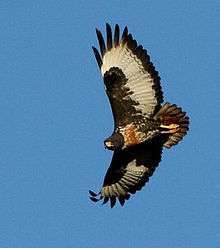Jackal buzzard
| Jackal buzzard | |
|---|---|
 | |
| Jackal Buzzard flying in Ithala Game Reserve | |
| Scientific classification | |
| Kingdom: | Animalia |
| Phylum: | Chordata |
| Class: | Aves |
| Order: | Accipitriformes |
| Family: | Accipitridae |
| Genus: | Buteo |
| Species: | B. rufofuscus |
| Binomial name | |
| Buteo rufofuscus (Forster, 1798) | |
| Subspecies | |
|
3 ssp., see text | |
The jackal buzzard (Buteo rufofuscus) is a 45–55 cm long African bird of prey. The taxonomy on this species is confusing, with some taxonomists considering this species, the Archer's buzzard, and the augur buzzard to be the same superspecies. Many taxonomists consider them all to be distinct, having different calls, different home ranges and variations in plumage. This is a species that lives among mountains, and on adjacent savanna and grassland. It is resident and non-migratory throughout its range.
Description
The adult South African jackal buzzard is strikingly plumaged. It is almost black above with a rufous tail. The primary flight feathers are blackish and the secondaries off-white, both barred with black. Below the chin and around the throat is mainly chestnut, and the rest of the underparts and the underwing coverts are rich rufous. The flight feathers from below are white, tipped with black to form a dark trailing edge to the wing.
The juvenile jackal buzzard is mainly brown above and rufous brown below and on the tail.
The jackal buzzard has a weeah ka-ka-ka call like that of black-backed jackal, hence its name. It is also reminiscent of the call of the American red-tailed hawk.
Behaviour
Pairs have noisy aerial displays, including outside the breeding season. The large (up to 1 m wide) stick nest is built in a tree or on a crag, and is often reused and enlarged in subsequent seasons. Two creamy or bluish white eggs are laid and incubated by the female only, although food is brought to her on the nest by the male.
The eggs hatch in about 40 days, and after a further 56–60 days they can attempt flight. At 70 days they become independent of the nest, but young birds may then be seen with the adult pair for some time.
The diet of the jackal buzzard is mainly small ground mammals, but snakes, lizards, small ground birds, insects, and road-kill are also taken. Typically, the raptor drops on its prey from a perch or hover.
References
- ↑ BirdLife International (2012). "Buteo rufofuscus". IUCN Red List of Threatened Species. Version 2013.2. International Union for Conservation of Nature. Retrieved 26 November 2013.
- Ferguson-Lees, Christie, Franklin, Mead and Burton Raptors of the World ISBN 0-7136-8026-1
- Ian Sinclair, Phil Hockey and Warwick Tarboton, SASOL Birds of Southern Africa (Struik 2002) ISBN 1-86872-721-1
External links
- Jackal Buzzard - Species text in The Atlas of Southern African Birds
| Wikimedia Commons has media related to Buteo rufofuscus. |
